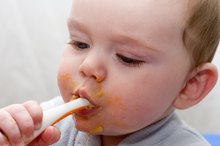Bad Breath in Infants
The smell of a freshly bathed baby can an intoxicating aroma for many new parents, and there are no shortage of creams, lotions and powders available to keep baby smelling sweet. But in some infants, the scent can be marred by bad breath, a symptom that should be checked by a pediatrician in order to rule out a potentially serious illness 2.**
Common Causes
According to Dr. Greene, the most common cause of bad breath in babies is breathing through the mouth, which results in bacterial growth. Sucking on the fingers, a thumb, or a blanket may also dry out the mouth and cause bad breath. If your baby sucks on a pacifier or other comfort object, their saliva and the oral bacteria in it, gets transferred onto this object. As a result, their toys or pacifiers may develop an unpleasant smell, which can then be transferred to the objects they touch, including the baby’s mouth. Sometimes, the food a baby eats will also cause bad breath.
- According to Dr. Greene, the most common cause of bad breath in babies is breathing through the mouth, which results in bacterial growth.
- As a result, their toys or pacifiers may develop an unpleasant smell, which can then be transferred to the objects they touch, including the baby’s mouth.
Medical Causes
The Causes of Smelly Feet in Infants
Learn More
Babies and children who breathe through their mouth might have an allergy, a cold or a sinus infection blocking the nasal passages. Bad breath in an older infant may signify an object, such as a bean or a bead, stuck in a nostril 2.** Baby bad breath may also be caused by gastro-esophageal reflux (acid bad breath reflux) or spitting up food. If you think this is the case, have the baby examined by a pediatrician. Rarely, bad breath may signify a medical condition such as diabetes, a kidney or urinary condition, or tonsillitis.
- Babies and children who breathe through their mouth might have an allergy, a cold or a sinus infection blocking the nasal passages.
- Bad breath in an older infant may signify an object, such as a bean or a bead, stuck in a nostril 2 or spitting up food.
Oral Hygeine
It is never to early to start proper oral hygiene habits with your baby. To prevent and cure bad breath, brush your baby's gums and teeth, if he has any, with a soft toothbrush especially designed for a baby 3. Or, just wipe his gums and tongue every after feeding. Offer sips of water after each feeding to wash away any food particles that remain on the gums or teeth.
- It is never to early to start proper oral hygiene habits with your baby.
- To prevent and cure bad breath, brush your baby's gums and teeth, if he has any, with a soft toothbrush especially designed for a baby 3.
Keeping Clean
High-Fat, Non-Dairy Foods for Babies
Learn More
Wash your baby's hands frequently with soap and water if she sucks his fingers or thumb, and wash her security objects, such as blankets or stuffed animals, often. If she uses a pacifier, sterilize it by running it through the dishwasher or dropping it in boiling water for five minutes.
Seek Advice
When your child is between 2- and 3-years old, take him for regular dental checkups to make sure that his teeth are clean and healthy. If the dentist says that they are, and your baby still has bad breath, take him to his pediatrician for a checkup to rule out any potential serious conditions 3.**
Related Articles
References
- Dr. Greene: Unusual Breath Odors and What They Mean
- Infant Bad Breath: Can an Infant Have Bad Breath?
- Baby Bad Breath! What's a Parent to Do?
- Aylıkcı BU, Colak H. Halitosis: From diagnosis to management. J Nat Sci Biol Med. 2013;4(1):14-23. doi:10.4103/0976-9668.107255
- Veeresha KL, Bansal M, Bansal V. Halitosis: A frequently ignored social condition. J Int Soc Prev Community Dent. 2011;1(1):9-13. doi:10.4103/2231-0762.86374
- Cleveland Clinic. Bad breath (halitosis): Possible causes. Updated May 1, 2018.
- American Academy of Oral Medicine. Gingival enlargement. Updated January 22, 2015.
- López-Pintor RM, Casañas E, González-Serrano J, et al. Xerostomia, hyposalivation, and salivary flow in diabetes patients. J Diabetes Res. 2016;2016:4372852. doi:10.1155/2016/4372852
- Pinna R, Campus G, Cumbo E, Mura I, Milia E. Xerostomia induced by radiotherapy: an overview of the physiopathology, clinical evidence, and management of the oral damage. Ther Clin Risk Manag. 2015;11:171-88. doi:10.2147/TCRM.S70652
- American Dental Association. Bad breath: Causes and tips for controlling it. 2012.
- Cleveland Clinic. Bad breath (halitosis): Care and treatment. Updated May 1, 2018.
- Kapoor U, Sharma G, Juneja M, Nagpal A. Halitosis: Current concepts on etiology, diagnosis and management. Eur J Dent. 2016;10(2):292-300. doi:10.4103/1305-7456.178294
- Aylıkcı BU, Colak H. "Halitosis: From Diagnosis to Management." J Nat Sci Biol Med. 2013;4(1):14-23. doi: 10.4103/0976-9668.107255
Writer Bio
Lisa Weber is a freelance writer/editor and former special education teacher. She has a bachelor's degree in journalism and professional writing, and a master's degree in special education. Over the last 15 years, she has written for a variety of newspapers, magazines, and on-line publications.









